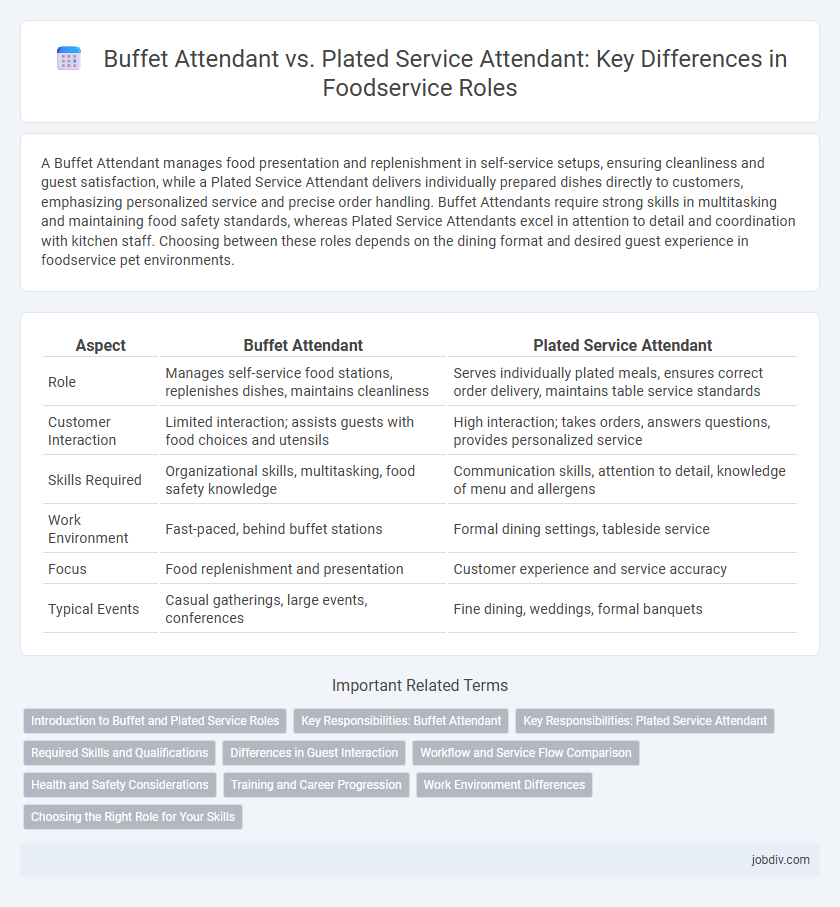A Buffet Attendant manages food presentation and replenishment in self-service setups, ensuring cleanliness and guest satisfaction, while a Plated Service Attendant delivers individually prepared dishes directly to customers, emphasizing personalized service and precise order handling. Buffet Attendants require strong skills in multitasking and maintaining food safety standards, whereas Plated Service Attendants excel in attention to detail and coordination with kitchen staff. Choosing between these roles depends on the dining format and desired guest experience in foodservice pet environments.
Table of Comparison
| Aspect | Buffet Attendant | Plated Service Attendant |
|---|---|---|
| Role | Manages self-service food stations, replenishes dishes, maintains cleanliness | Serves individually plated meals, ensures correct order delivery, maintains table service standards |
| Customer Interaction | Limited interaction; assists guests with food choices and utensils | High interaction; takes orders, answers questions, provides personalized service |
| Skills Required | Organizational skills, multitasking, food safety knowledge | Communication skills, attention to detail, knowledge of menu and allergens |
| Work Environment | Fast-paced, behind buffet stations | Formal dining settings, tableside service |
| Focus | Food replenishment and presentation | Customer experience and service accuracy |
| Typical Events | Casual gatherings, large events, conferences | Fine dining, weddings, formal banquets |
Introduction to Buffet and Plated Service Roles
Buffet attendants manage the self-service flow by replenishing dishes, maintaining cleanliness, and assisting guests with food selections, ensuring a seamless dining experience in high-volume settings. Plated service attendants focus on delivering individually prepared meals directly to guests, emphasizing presentation, timing, and personalized service in formal dining environments. Both roles require attention to customer satisfaction and efficiency but differ significantly in interaction style and operational responsibilities.
Key Responsibilities: Buffet Attendant
Buffet attendants manage food replenishment, ensuring dishes are consistently stocked and visually appealing while maintaining hygiene standards. They monitor food temperatures and presentation, promptly addressing any spills or messes to uphold safety and cleanliness. Customer interaction involves guiding guests through offerings, answering questions, and assisting with special dietary needs to enhance the dining experience.
Key Responsibilities: Plated Service Attendant
Plated Service Attendants specialize in delivering individually portioned meals directly to guests, ensuring accuracy, presentation, and timing while maintaining high standards of hygiene and customer interaction. They coordinate closely with kitchen staff to guarantee seamless service flow and promptly address guest needs or dietary restrictions. Expertise in carrying multiple dishes and managing table settings enhances guest satisfaction and operational efficiency in fine dining environments.
Required Skills and Qualifications
Buffet attendants require strong organizational skills, customer service expertise, and the ability to maintain cleanliness and food safety standards in high-traffic environments. Plated service attendants must excel in formal dining etiquette, precision in food presentation, and communication skills to interact with guests and coordinate with kitchen staff. Both roles demand attention to detail, stamina for prolonged standing, and knowledge of health regulations within the foodservice industry.
Differences in Guest Interaction
Buffet attendants primarily facilitate self-service by maintaining food presentation and replenishing stations, resulting in minimal direct guest interaction. Plated service attendants engage in personalized service by taking orders, serving meals directly, and attending to specific guest needs throughout the dining experience. The level of guest interaction differs significantly, with plated service attendants providing a more tailored and attentive customer experience.
Workflow and Service Flow Comparison
Buffet attendants manage continuous guest interaction by replenishing food stations and maintaining cleanliness, ensuring a smooth, self-service workflow that facilitates quick guest turnover. Plated service attendants follow a structured sequence of taking orders, delivering individually plated dishes, and providing personalized guest attention, requiring meticulous coordination with kitchen staff to maintain service timing. Workflow efficiency in buffet service prioritizes speed and accessibility, while plated service emphasizes precision and elevated guest experience.
Health and Safety Considerations
Buffet attendants must implement rigorous hygiene protocols such as frequent handwashing, wearing gloves, and using utensils to prevent cross-contamination when handling shared food items. Plated service attendants emphasize individual portion control and minimize food exposure, reducing the risk of airborne contaminants and ensuring compliance with food safety standards. Both roles require adherence to local health regulations, regular temperature monitoring, and prompt cleaning of service areas to maintain a safe dining environment.
Training and Career Progression
Buffet attendants require training in food safety, guest interaction, and efficient replenishment techniques, while plated service attendants need skills in precise food presentation, timing, and personalized guest service. Career progression for buffet attendants typically advances to supervisory roles in catering or event management, whereas plated service attendants often move toward fine dining leadership positions, such as maitre d' or banquet captain. Both paths demand strong communication and customer service skills, with tailored training programs enhancing expertise in their respective service styles.
Work Environment Differences
Buffet attendants operate in fast-paced, open settings where they replenish food stations and assist guests in self-service areas, often standing for long periods and managing high guest turnover. Plated service attendants work primarily in formal dining rooms, delivering individual dishes with attention to presentation and guest preferences, requiring more interaction and precision. The buffet role emphasizes efficiency and crowd management, while plated service demands refined table etiquette and personalized customer care.
Choosing the Right Role for Your Skills
Buffet attendants excel in fast-paced environments, handling large crowds efficiently by replenishing food and maintaining cleanliness. Plated service attendants require strong attention to detail and customer interaction skills, delivering personalized dining experiences. Assess your strengths in multitasking versus personalized service to choose the role that best suits your abilities in foodservice.
Buffet Attendant vs Plated Service Attendant Infographic

 jobdiv.com
jobdiv.com